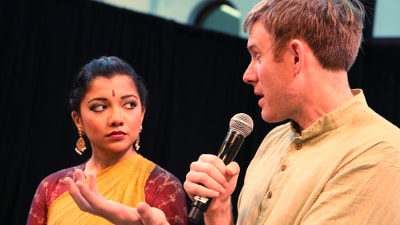Social Historian Sways Smithsonian Dance Performance
By Emily Stimmel / 412-268-1788 / estimmel@andrew.cmu.edu
Nico Slate never imagined his historical research would inspire dance performances.
But that's exactly what happened at the Smithsonian's "CrossLines: A Culture Lab on Intersectionality," in which renowned bharatanatyam dancer and choreographer Anjal Chande reimagined the Carnegie Mellon University associate history professor's work on the anti-racist solidarities between South Asians and African-Americans.
 Bharatanatyam is a solo dance that depicts various characters through swift turns and movements that follow the narrative of a song or story.
Bharatanatyam is a solo dance that depicts various characters through swift turns and movements that follow the narrative of a song or story.
"It was deeply moving to see the history I study brought to life in the form of such a powerful and intricately expressive work of art and especially meaningful to see audiences full of young people inspired to learn more about the long struggle against racism throughout the world," Slate said.
This was the first time the Smithsonian's Asian-Pacific American Center hosted CrossLines, which brought together more than 40 artists and scholars. It was designed to celebrate Asian-Pacific American Heritage Month and engage the public in an experience that illustrates the rich diversity of Asian-Pacific American stories. The event marked the first time since 2004 that the Smithsonian's Arts and Industries Building was open to the public.
CrossLines' curator Adriel Luis described the event as highlighting work from culturally diverse artists in a wide variety of media.
"Museums are known as places that segment. This is about crossing lines between different communities and different forms of art," Luis told the Washington Post.
Chande used two of Slate's books to form the basis of her performance: "Colored Cosmopolitanism: The Shared Struggle for Freedom in the Unites States and India" and "The Prism of Race: W.E.B. DuBois, Langston Hughes, Paul Robseson and the Colored World of Cedric Dover."
In particular, she focused on the life of South Asian feminist and anti-colonial activist Kamaladevi Chattopadhyaya.
"I felt honored by the opportunity to explore Nico's comprehensive research and allow my creative impulses to express the deeply inspiring solidarity of activists he so thoughtfully wrote about," Chande said. "In the process, I discovered numerous unsung heroes who fought various global oppressions and who serve as a reminder that courage, compassion and creativity are all needed to imagine how to address the injustices that still persist today."
There were four performances of Out of the Shadows, A Colored Solidarity," and Slate joined Chande onstage for audience Q&A sessions after each one. Most questions focused on the larger history that informed the piece and the process of creating a hybrid historical dance.
"I left the event grateful for the opportunity to collaborate with such a talented choreographer and dancer, and to share the history of anti-racist solidarities with the audiences and the other artists at CrossLines," Slate said.
CrossLines showcased other visual and performance art by groups including D.C. artist SUPERWAXX, whose collective works are heavily influenced by pop culture and street art; Wooden Wave, a Hawaiian duo whose interactive Treehouse Mural served as the entrance piece to the event; and a California-based trio of artists called People's Kitchen Collective, who created a mock pharmacy counter where they dispensed edible "remedies" and invited participants to share family healing practices.
Slate and Chande are planning to bring their collaboration to new venues worldwide — including CMU — and are exploring how the piece can be expanded to highlight other key figures and moments in the history of connections between African-American and South Asian freedom struggles.